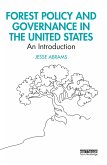- Broschiertes Buch
- Merkliste
- Auf die Merkliste
- Bewerten Bewerten
- Teilen
- Produkt teilen
- Produkterinnerung
- Produkterinnerung
Explores conflicts and the way in which these tensions shape the way these differences are translated into environmental policies in the United States.
Andere Kunden interessierten sich auch für
![The European Environmental Conscience in EU Politics The European Environmental Conscience in EU Politics]() The European Environmental Conscience in EU Politics123,99 €
The European Environmental Conscience in EU Politics123,99 €![Governing the Interlinkages between the SDGs Governing the Interlinkages between the SDGs]() Governing the Interlinkages between the SDGs33,99 €
Governing the Interlinkages between the SDGs33,99 €![Energy Capitol Energy Capitol]() Arthur MasonEnergy Capitol51,99 €
Arthur MasonEnergy Capitol51,99 €![Forest Policy and Governance in the United States Forest Policy and Governance in the United States]() Jesse AbramsForest Policy and Governance in the United States63,99 €
Jesse AbramsForest Policy and Governance in the United States63,99 €![Obstacles to Environmental Progress Obstacles to Environmental Progress]() Peter C. SchulzeObstacles to Environmental Progress40,99 €
Peter C. SchulzeObstacles to Environmental Progress40,99 €![The Conservative Environmentalist The Conservative Environmentalist]() Benji BackerThe Conservative Environmentalist30,99 €
Benji BackerThe Conservative Environmentalist30,99 €![National Parks Forever National Parks Forever]() Jonathan B. JarvisNational Parks Forever26,99 €
Jonathan B. JarvisNational Parks Forever26,99 €-
-
-
Explores conflicts and the way in which these tensions shape the way these differences are translated into environmental policies in the United States.
Hinweis: Dieser Artikel kann nur an eine deutsche Lieferadresse ausgeliefert werden.
Hinweis: Dieser Artikel kann nur an eine deutsche Lieferadresse ausgeliefert werden.
Produktdetails
- Produktdetails
- Verlag: SAGE Publications Inc
- 5 Revised edition
- Seitenzahl: 664
- Erscheinungstermin: 15. Oktober 2019
- Englisch
- Abmessung: 153mm x 356mm x 18mm
- Gewicht: 798g
- ISBN-13: 9781506396965
- ISBN-10: 1506396968
- Artikelnr.: 55187199
- Herstellerkennzeichnung Die Herstellerinformationen sind derzeit nicht verfügbar.
- Verlag: SAGE Publications Inc
- 5 Revised edition
- Seitenzahl: 664
- Erscheinungstermin: 15. Oktober 2019
- Englisch
- Abmessung: 153mm x 356mm x 18mm
- Gewicht: 798g
- ISBN-13: 9781506396965
- ISBN-10: 1506396968
- Artikelnr.: 55187199
- Herstellerkennzeichnung Die Herstellerinformationen sind derzeit nicht verfügbar.
Judith A. Layzer was professor of environmental policy in the Department of Urban Studies and Planning at the Massachusetts Institute of Technology (MIT) until her death in 2015. She earned a Ph.D. in political science at MIT. After four years at Middlebury College in Vermont she returned to MIT, where she taught courses in science and politics in environmental policymaking, ecosystem-based management, food systems and the environment, urban sustainability, energy and environmental politics, and public policy. Layzer¿s research focused on several aspects of U.S. environmental politics, including the roles of science, values, and storytelling in environmental politics, as well as on the effectiveness of different approaches to environmental planning and management. A recent project asked: Do urban sustainability initiatives significantly reduce cities¿ ecological footprints? And which aspects of ¿green cities¿ are most effective at reducing cities¿ environmental impacts? In addition to The Environmental Case, Layzer was the author of Natural Experiments: Ecosystem-Based Management and the Environment (2008) and Open for Business: Conservatives¿ Opposition to Environmental Regulation (2012). Layzer was an athlete as well as a scholar. In addition to having finished five Boston marathons, she shared nine national championship titles and one world championship trophy with her teammates on Lady Godiva, formerly Boston¿s premier women¿s Ultimate Frisbee team. Judith A. Layzer 1961¿2015
Preface Acknowledgments About the Authors CHAPTER 1
A Policymaking Framework: Defining Problems and Portraying Solutions in U.S. Environmental Politics Two Critical Features of U.S. Environmental Policymaking Major Actors in Environmental Policymaking The Environmental Policymaking Process Case Selection Getting the Most Out of the Cases Notes PART I
REGULATING POLLUTERS CHAPTER 2
The Nation Tackles Air and Water Pollution: The Environmental Protection Agency and the Clean Air and Clean Water Acts Background The Case Outcomes Conclusions Questions to Consider Notes CHAPTER 3
Love Canal: Hazardous Waste and the Politics of Fear Background The Case Outcomes Conclusions Questions to Consider Notes CHAPTER 4
Ecosystem-Based Management in the Chesapeake Bay Background The Case Outcomes Conclusions Questions to Consider Notes CHAPTER 5
Market-Based Solutions: Acid Rain and the Clean Air Act Amendments of 1990 Background The Case Outcomes Conclusions Questions to Consider Notes PART II
HISTORY, CHANGING VALUES, AND NATURAL RESOURCE MANAGEMENT CHAPTER 6
Oil Versus Wilderness in the Arctic National Wildlife Refuge Background The Case Obama Legacy Outcomes Conclusions Questions to Consider Notes CHAPTER 7
Federal Grazing Policy: Some Things Never Change Background The Case Outcomes Conclusions Questions to Consider Notes CHAPTER 8
Jobs Versus the Environment: Saving the Northern Spotted Owl Background The Case Outcomes Conclusions Questions to Consider Notes CHAPTER 9
Playground or Paradise? Snowmobiles in Yellowstone National Park Background The Case Outcomes Conclusions Questions to Consider Notes CHAPTER 10
Crisis and Recovery in the New England Fisheries Background The Case Outcomes Conclusions Questions to Consider Notes CHAPTER 11
The Deepwater Horizon Disaster: The High Cost of Offshore Oil Background The Case Outcomes Conclusions Questions to Consider Notes PART III
NEW ISSUES, NEW POLITICS CHAPTER 12
Climate Change: The Crisis of Our Time Background The Case Outcomes Conclusions Questions to Consider Notes CHAPTER 13
Cape Wind: If Not Here, Where? If Not Now, When? Background The Case Outcomes Conclusions Questions to Consider Notes CHAPTER 14
Fracking Wars: Local and State Responses to Unconventional Shale Gas Development Background The Case Outcomes Conclusions Questions to Consider Notes CHAPTER 15
Making Trade-Offs: Urban Sprawl and the Evolving System of Growth Management in Portland, Oregon Background The Case Outcomes Conclusions Questions to Consider Notes CHAPTER 16
Post-Katrina: Lessons From a Disaster Background The Case Outcomes Conclusions Questions to Consider Notes CHAPTER 17
Conclusions: Politics, Values, and Environmental Policy Change The Strength of the Status Quo Legislative Policy Change Administrative Policy Change Acknowledging the Role of Values Notes Index
A Policymaking Framework: Defining Problems and Portraying Solutions in U.S. Environmental Politics Two Critical Features of U.S. Environmental Policymaking Major Actors in Environmental Policymaking The Environmental Policymaking Process Case Selection Getting the Most Out of the Cases Notes PART I
REGULATING POLLUTERS CHAPTER 2
The Nation Tackles Air and Water Pollution: The Environmental Protection Agency and the Clean Air and Clean Water Acts Background The Case Outcomes Conclusions Questions to Consider Notes CHAPTER 3
Love Canal: Hazardous Waste and the Politics of Fear Background The Case Outcomes Conclusions Questions to Consider Notes CHAPTER 4
Ecosystem-Based Management in the Chesapeake Bay Background The Case Outcomes Conclusions Questions to Consider Notes CHAPTER 5
Market-Based Solutions: Acid Rain and the Clean Air Act Amendments of 1990 Background The Case Outcomes Conclusions Questions to Consider Notes PART II
HISTORY, CHANGING VALUES, AND NATURAL RESOURCE MANAGEMENT CHAPTER 6
Oil Versus Wilderness in the Arctic National Wildlife Refuge Background The Case Obama Legacy Outcomes Conclusions Questions to Consider Notes CHAPTER 7
Federal Grazing Policy: Some Things Never Change Background The Case Outcomes Conclusions Questions to Consider Notes CHAPTER 8
Jobs Versus the Environment: Saving the Northern Spotted Owl Background The Case Outcomes Conclusions Questions to Consider Notes CHAPTER 9
Playground or Paradise? Snowmobiles in Yellowstone National Park Background The Case Outcomes Conclusions Questions to Consider Notes CHAPTER 10
Crisis and Recovery in the New England Fisheries Background The Case Outcomes Conclusions Questions to Consider Notes CHAPTER 11
The Deepwater Horizon Disaster: The High Cost of Offshore Oil Background The Case Outcomes Conclusions Questions to Consider Notes PART III
NEW ISSUES, NEW POLITICS CHAPTER 12
Climate Change: The Crisis of Our Time Background The Case Outcomes Conclusions Questions to Consider Notes CHAPTER 13
Cape Wind: If Not Here, Where? If Not Now, When? Background The Case Outcomes Conclusions Questions to Consider Notes CHAPTER 14
Fracking Wars: Local and State Responses to Unconventional Shale Gas Development Background The Case Outcomes Conclusions Questions to Consider Notes CHAPTER 15
Making Trade-Offs: Urban Sprawl and the Evolving System of Growth Management in Portland, Oregon Background The Case Outcomes Conclusions Questions to Consider Notes CHAPTER 16
Post-Katrina: Lessons From a Disaster Background The Case Outcomes Conclusions Questions to Consider Notes CHAPTER 17
Conclusions: Politics, Values, and Environmental Policy Change The Strength of the Status Quo Legislative Policy Change Administrative Policy Change Acknowledging the Role of Values Notes Index
Preface Acknowledgments About the Authors CHAPTER 1
A Policymaking Framework: Defining Problems and Portraying Solutions in U.S. Environmental Politics Two Critical Features of U.S. Environmental Policymaking Major Actors in Environmental Policymaking The Environmental Policymaking Process Case Selection Getting the Most Out of the Cases Notes PART I
REGULATING POLLUTERS CHAPTER 2
The Nation Tackles Air and Water Pollution: The Environmental Protection Agency and the Clean Air and Clean Water Acts Background The Case Outcomes Conclusions Questions to Consider Notes CHAPTER 3
Love Canal: Hazardous Waste and the Politics of Fear Background The Case Outcomes Conclusions Questions to Consider Notes CHAPTER 4
Ecosystem-Based Management in the Chesapeake Bay Background The Case Outcomes Conclusions Questions to Consider Notes CHAPTER 5
Market-Based Solutions: Acid Rain and the Clean Air Act Amendments of 1990 Background The Case Outcomes Conclusions Questions to Consider Notes PART II
HISTORY, CHANGING VALUES, AND NATURAL RESOURCE MANAGEMENT CHAPTER 6
Oil Versus Wilderness in the Arctic National Wildlife Refuge Background The Case Obama Legacy Outcomes Conclusions Questions to Consider Notes CHAPTER 7
Federal Grazing Policy: Some Things Never Change Background The Case Outcomes Conclusions Questions to Consider Notes CHAPTER 8
Jobs Versus the Environment: Saving the Northern Spotted Owl Background The Case Outcomes Conclusions Questions to Consider Notes CHAPTER 9
Playground or Paradise? Snowmobiles in Yellowstone National Park Background The Case Outcomes Conclusions Questions to Consider Notes CHAPTER 10
Crisis and Recovery in the New England Fisheries Background The Case Outcomes Conclusions Questions to Consider Notes CHAPTER 11
The Deepwater Horizon Disaster: The High Cost of Offshore Oil Background The Case Outcomes Conclusions Questions to Consider Notes PART III
NEW ISSUES, NEW POLITICS CHAPTER 12
Climate Change: The Crisis of Our Time Background The Case Outcomes Conclusions Questions to Consider Notes CHAPTER 13
Cape Wind: If Not Here, Where? If Not Now, When? Background The Case Outcomes Conclusions Questions to Consider Notes CHAPTER 14
Fracking Wars: Local and State Responses to Unconventional Shale Gas Development Background The Case Outcomes Conclusions Questions to Consider Notes CHAPTER 15
Making Trade-Offs: Urban Sprawl and the Evolving System of Growth Management in Portland, Oregon Background The Case Outcomes Conclusions Questions to Consider Notes CHAPTER 16
Post-Katrina: Lessons From a Disaster Background The Case Outcomes Conclusions Questions to Consider Notes CHAPTER 17
Conclusions: Politics, Values, and Environmental Policy Change The Strength of the Status Quo Legislative Policy Change Administrative Policy Change Acknowledging the Role of Values Notes Index
A Policymaking Framework: Defining Problems and Portraying Solutions in U.S. Environmental Politics Two Critical Features of U.S. Environmental Policymaking Major Actors in Environmental Policymaking The Environmental Policymaking Process Case Selection Getting the Most Out of the Cases Notes PART I
REGULATING POLLUTERS CHAPTER 2
The Nation Tackles Air and Water Pollution: The Environmental Protection Agency and the Clean Air and Clean Water Acts Background The Case Outcomes Conclusions Questions to Consider Notes CHAPTER 3
Love Canal: Hazardous Waste and the Politics of Fear Background The Case Outcomes Conclusions Questions to Consider Notes CHAPTER 4
Ecosystem-Based Management in the Chesapeake Bay Background The Case Outcomes Conclusions Questions to Consider Notes CHAPTER 5
Market-Based Solutions: Acid Rain and the Clean Air Act Amendments of 1990 Background The Case Outcomes Conclusions Questions to Consider Notes PART II
HISTORY, CHANGING VALUES, AND NATURAL RESOURCE MANAGEMENT CHAPTER 6
Oil Versus Wilderness in the Arctic National Wildlife Refuge Background The Case Obama Legacy Outcomes Conclusions Questions to Consider Notes CHAPTER 7
Federal Grazing Policy: Some Things Never Change Background The Case Outcomes Conclusions Questions to Consider Notes CHAPTER 8
Jobs Versus the Environment: Saving the Northern Spotted Owl Background The Case Outcomes Conclusions Questions to Consider Notes CHAPTER 9
Playground or Paradise? Snowmobiles in Yellowstone National Park Background The Case Outcomes Conclusions Questions to Consider Notes CHAPTER 10
Crisis and Recovery in the New England Fisheries Background The Case Outcomes Conclusions Questions to Consider Notes CHAPTER 11
The Deepwater Horizon Disaster: The High Cost of Offshore Oil Background The Case Outcomes Conclusions Questions to Consider Notes PART III
NEW ISSUES, NEW POLITICS CHAPTER 12
Climate Change: The Crisis of Our Time Background The Case Outcomes Conclusions Questions to Consider Notes CHAPTER 13
Cape Wind: If Not Here, Where? If Not Now, When? Background The Case Outcomes Conclusions Questions to Consider Notes CHAPTER 14
Fracking Wars: Local and State Responses to Unconventional Shale Gas Development Background The Case Outcomes Conclusions Questions to Consider Notes CHAPTER 15
Making Trade-Offs: Urban Sprawl and the Evolving System of Growth Management in Portland, Oregon Background The Case Outcomes Conclusions Questions to Consider Notes CHAPTER 16
Post-Katrina: Lessons From a Disaster Background The Case Outcomes Conclusions Questions to Consider Notes CHAPTER 17
Conclusions: Politics, Values, and Environmental Policy Change The Strength of the Status Quo Legislative Policy Change Administrative Policy Change Acknowledging the Role of Values Notes Index








